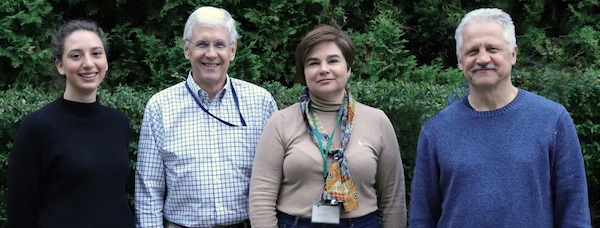Charles Allen Lab

Research interests
Human society has rigid schedules for work, school, and social activities. These schedules frequently require people to work and be active when their endogenous circadian clock is signaling it is time to sleep. There are substantial clinical and laboratory data showing the importance of synchronized circadian rhythmicity to overall health, and that circadian disruption causes early death and notable changes in the brain, metabolism, and behavior. The master mammalian circadian clock, located in the suprachiasmatic nucleus (SCN) of the hypothalamus maintains the proper phase relationship between circadian clocks located in tissues and organs throughout the body and entrains the circadian system to the environment. The SCN is composed of individual neuronal oscillators linked by intercellular communication into a neural network that generates a robust and precise rhythm. The long-term goal of our research is to understand the intracellular and intercellular signaling mechanisms that couple SCN neurons into a neural network that generates circadian rhythms.

Research projects
GABA is the most abundant neurotransmitter in the SCN, where it regulates many functions, including light-induced phase shifts, synchronization of the dorsal and ventral SCN, synchronization of the circadian phase of individual SCN neurons, and the sensitivity of the circadian clock to light-entraining signals. The strength and functional consequences of GABA(A) receptor activation (whether inhibitory or excitatory) show dynamic regulation by the circadian clock. Further, GABA activates postsynaptic GABA(A) receptors located at structurally specialized synapses, which mediates fast interneuronal communication and extrasynaptic receptors which mediate a tonic GABA current. However, it remains largely unknown how these two GABA currents regulate the activity and synchrony of the SCN neural network. We hypothesize that the synaptic and tonic GABA(A) receptor-mediated currents have to play different roles in the generation of circadian output (Moldavan et al., 2017). We are using fluorescence imaging of circadian clock gene activity and electrophysiological methods to examine the effects of selective modulation of either the synaptic or tonic GABA current on the synchrony of SCN neurons.
The chloride cotransporters of the sodium-potassium-chloride (NKCC) and potassium-chloride (KCC) families control the intracellular Cl- concentration and the polarity and magnitude of the GABA(A) receptor-mediated current. In the adult SCN, GABA may serve as both an inhibitory and excitatory neurotransmitter although the physiological significance of this change in the polarity GABA neurotransmission remains poorly understood. We propose that the circadian clock uses intracellular second messenger systems WNK/SPAK kinases and Ca2+- and cyclic AMP-activated kinases to regulate the activity of the Cl- cotransporters (Klett & Allen, 2017). We hypothesize that circadian regulation of the intracellular Cl- gradient is a critical factor in the generation of a coherent circadian rhythm. Single neuron fluorescent imaging of circadian clock gene activity and will be used to determine how regulation of Cl- cotransporter activity alters the robustness of the circadian rhythm and the synchrony of the circadian clocks in SCN neurons. We propose that the circadian clock regulates the activity of the NKCC1 and KCC2 of GABAergic synapses by activating intracellular signaling pathways including WNK/SPAK, Protein Kinase A, and Protein kinase C. Single cell electrophysiological recording and Cl- imaging techniques are being used to examine the signaling mechanisms that regulate Cl- cotransporter activity.
The network of SCN neurons and astrocytes, which also express molecular clocks, are required for a precise and stable circadian signal. Astrocytes regulate neuronal function in multiple ways, from buffering extracellular ion and neurotransmitter concentrations, to regulating blood oxygen and metabolism, and actively responding to external cues through intracellular signaling molecules such as Ca2+ and inducing the release of neuromodulators such as ATP, glutamate, or adenosine. Astrocytes regulate clock gene expression and neuronal synchrony in culture systems, but how astrocytes regulate neuronal function within the SCN remains largely unknown. SCN astrocytes respond to the light-dark cycle with changes in activity and morphology, which may be an essential modulator of synaptic transmission in the SCN. We hypothesize that astrocytes are a crucial component of the SCN network and astrocyte rhythmicity is necessary for proper photic entrainment and that astrocytes modulate the circadian period length.
The GABA transporters GAT-1 and GAT-3 regulate the amount and duration of neurotransmitter GABA in the synaptic cleft and extrasynaptic space. We recently demonstrated that in the SCN, the GATs are only expressed in astrocytes suggesting that astrocytes play a vital role in regulating the physiological actions of GABA in the SCN network. (Moldavan et al., 2015). Identify the role that astrocyte activity plays in the regulation of GABAergic neurotransmission in the SCN. We are testing the hypothesis that SCN astrocytes regulate the activity of both fast synaptic and tonic GABAA receptor-mediated neurotransmission. We are using pharmacological tools (DREADD receptors) to activate intracellular Ca2+ signaling pathway in GFAP-expressing astrocytes and record the changes in synaptic and extrasynaptic GABA(A) receptor-mediated currents.
In the second line of research chemogenic methods are being used to modify astrocyte activity, and the synchrony of individual SCN neuronal circadian oscillators, which will be determined using long-duration imaging methods. A transgenic mouse model is being used to induce period mismatch between SCN astrocytes and neurons. Bioluminescent reporting of clock gene activity and circadian behavioral analysis will be used to test whether astrocytes regulate period length in the SCN and whether synchrony between astrocytes and neurons astrocytes govern circadian behavior.
Endocannabinoids, endogenously generated lipophilic molecules, act as retrograde signals from neurons to regulate presynaptic neurotransmitter release via activation of G protein-coupled cannabinoid-1 receptors (CB1R). The production and metabolism of endocannabinoids have diurnal patterns, indicating they may be under circadian clock control. Cannabinoid receptor activation blocks light-induced phase shifts of circadian behavior. In addition, cannabinoid signaling increases neuronal firing within the SCN by decreasing presynaptic GABA release. Given this evidence of interactions between the circadian and cannabinoid systems, surprisingly little is known about how cannabinoids alter SCN function and circadian clock timing. Endocannabinoids can alter neuronal function by activating astrocyte signaling pathways and the release of gliotransmitters. We hypothesize that cannabinoid signaling activates an intracellular Ca2+ signaling pathway in astrocytes and releases neuromodulators to alter SCN neuronal function and ultimately change circadian clock timing.
We propose that neuronal activity generates endocannabinoid release, activating astrocyte Ca2+ signaling, which releases adenosine and activates adenosine-1 receptors (A1Rs) on the presynaptic axon terminals, decreasing GABA release. We demonstrated that activation of cannabinoid-1 receptors (CB1R) with the agonist WIN 55,212-2 (WIN) reduced the miniature GABA receptor-mediated postsynaptic current (mGPSC) frequency by a mechanism that requires astrocytes and A1R. WIN activated an intracellular Ca2+ signaling pathway in astrocytes. Activating this intracellular Ca2+ pathway with DREADDs also decreased the mGPSC frequency and required A1R activation. The frequency of spontaneous Ca2+events, including those induced by depolarization of a postsynaptic SCN neuron, was reduced by blocking CB1R activation with AM251, demonstrating neuronal endocannabinoid signaling modulates astrocytic Ca2+signaling in the SCN. Finally, daytime application of WIN or adenosine phase advanced the molecular circadian clock, indicating that this cannabinoid signaling pathway is vital for the generation of circadian rhythms.
The neuroanatomy and synaptic mechanisms that mediate the strength of SCN coupling are sensitive to the hormonal environment, suggesting a role for sex and steroid influences. Sex steroids can alter behavior through effects on structure and function. These data suggest that either sex or androgen exposure or both may alter the electrical and neuroanatomical connectivity of the SCN. Androgens modulate the activity of GABA neurotransmission by binding to the GABA(A) receptor and altering the activation, inactivation, and desensitization kinetics. The effect of androgens on GABA receptors is dependent on the subunit composition of the receptor. The subunit structure determines whether the GABA(A) receptors are located at synapses or extrasynaptic locations and whether they mediate a synaptic or tonic GABA currents. An interaction between androgens and GABA neurotransmission may explain sex differences in the activity of the circadian clock. For example, the mean action potential firing frequency during the day of male SCN neurons is faster than in female mice. Inhibition of GABA(A) receptors decreases the firing frequency in male SCN neurons, so there is no difference with the female SCN. These data are consistent with a model in which androgens reduce the strength of GABA neurotransmission in male mice resulting in faster daytime firing frequencies. Androgens are positive allosteric modulators of GABA(A) receptors and we predict that androgens will increase the amplitude and slow the decay time constant of the spontaneous and miniature GABA(A) receptor-mediated currents in a concentration dependent manner. We also predict that androgen application will increase the amplitude of the tonic GABA current. We do not expect changes in the frequency of the miniature synaptic currents indicating that androgens do not alter the presynaptic release of GABA.
Lab members

Mykhaylo Moldavan, Ph.D. - Senior Research Associate
Dr. Moldavan received his Bachelor of Science in Biology from Kyiv State University in Kyiv, Ukraine and his Ph.D. in Physiology from the Bogomoletz Institute of Kyiv, Ukraine. He is studying the modulation, by presynaptic receptors, of optic nerve signaling to the suprachiasmatic nucleus. For more information

Olga Cravetchi, M.S., M.D. - Research Assistant III
Olga Cravetchi, Research Assistant III, joined the lab in August 2011. She received her MS in Experimental Medicine in 2009 from University of Alberta, Edmonton, Alberta, Canada and also got a MD in Pediatrics from the State University of Medicine, Moldova. Her work assists all projects that run in the laboratory. She performs neuronal cell cultures for intracellular imaging, molecular biology experiments as well as protein expression analysis using Western blot and IHC.